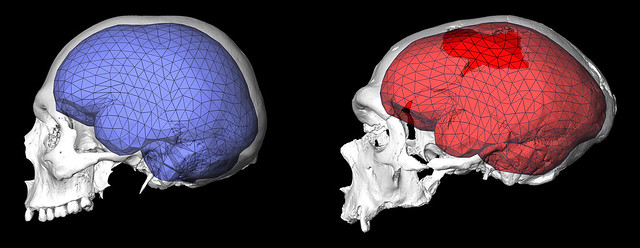
Although studies suggest that the brain size of Homo sapiens was within the modern human range as of about 300,000 years ago, more globular (or round) brain features exhibited by present-day humans only emerged approximately 40,000 years ago, according to a new fossil analysis. That’s roughly the time when the full suite of modern human behaviors emerged, say the authors. These findings demonstrate a more gradual appearance of so-called behavioral modernity, one in which brain shape played a part. Modern humans have large, globular brains which develop early and affect cognitive development; however, how and when globularity evolved, and how that relates to the evolutionary increase in brain size remains unknown. Using computed tomographic scans and sophisticated 3-D analyses to elucidate the evolution of brain shape, Simon Neubauer and colleagues analyzed endocranial casts of 20 H. sapiensfossils from different time periods, dating from about 300,000 to 10,000 years ago. Their analyses showed that endocranial shape variations of Upper Paleolithic and more recent specimens overlap with present-day human shape variations, ultimately suggesting brain shape reached current globularity ranges somewhere between 100,000 and 35,000 years ago – thus, not coincident with the evolution of larger brain size in earlier H. sapiens. Based on their fossil analyses as well as information about human behavior from archeological records, the authors believe the gradual globularization of the brain during evolution paralleled the emergence of behavioral modernity. As such, they say, the “human revolution” during the Middle to the Upper Paleolithic in Europe around 50,000 years ago was not due to a rapid evolutionary event related to a specific genetic change, but rather, was merely a point in time where gradual changes supported the full suite of modern behaviors.
_____________________________
Brain shape evolution in Homo sapiens. The left image shows brain shape as reconstructed based on micro computed tomographic scans of one of the earliest known members of our species, the fossil cranium Jebel Irhoud 1, dated to about 300,000 years. Brain shape, and possibly brain function, evolved gradually, and have reached the globularity typical for present-day humans (right image) only by about 35,000 years ago. Simon Neubauer, Philipp Gunz, MPI EVA Leipzig (License: CC-BY-SA 4.0)
_______________________________________
Brain shape comparison between Homo sapiensand Neandertals. The left image shows the globular endocranial shape of present-day humans as reconstructed based on micro computed tomographic scans. In contrast, endocranial shape of Neandertals like in La-Chapelle-aux-Saints shown on the right, but also in the earliest Homo sapiens fossils, is elongated. The typical globular human shape evolved gradually and reached modern conditions only recently – about 35,000 years ago. Simon Neubauer, Philipp Gunz, MPI EVA Leipzig (License: CC-BY-SA 4.0)
______________________________________
Article Source: AAAS news release
Cover image, top left: Modern human skull. Skimsta, Wikimedia Commons
______________________________________
Become a new Popular Archaeology premium subscriber.
___________________________________________
Travel and learn with Far Horizons.
______








